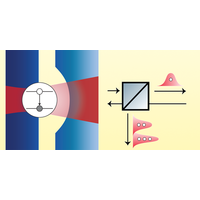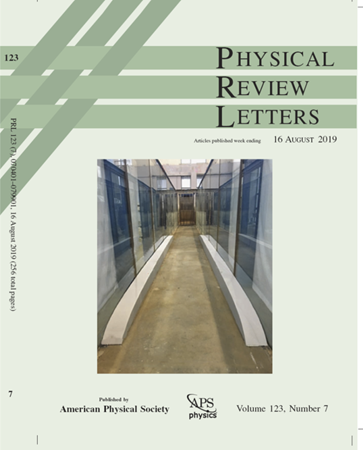实现连贯高效的一维原子
IF 9
1区 物理与天体物理
Q1 PHYSICS, MULTIDISCIPLINARY
引用次数: 0
摘要
量子发射器在单一光模式下与光子相互作用,构成一维原子。相干且高效耦合的一维原子具有很大的非线性,可实现光子量子门。实现高耦合效率(β 因子)和低衰减具有挑战性。在这里,我们使用开放微腔中的半导体量子点来实现一维原子。在微弱激光输入的情况下,我们实现了 99.2% 的透射消光和 g(2)(0)=587的光子统计束,展示了相干输入的单光子分量的反射和多光子分量的透射。微腔的可调谐特性允许调整 β,从而控制光子统计量--从强束集到反束集--以及传输光子的相位。我们超越了单模杰恩斯-康明斯模型,在实验和理论之间取得了极好的一致。我们的研究成果为创造奇异的光子态和双光子相位门铺平了道路。本文章由计算机程序翻译,如有差异,请以英文原文为准。

Realization of a Coherent and Efficient One-Dimensional Atom
A quantum emitter interacting with photons in a single optical-mode constitutes a one-dimensional atom. A coherent and efficiently coupled one-dimensional atom provides a large nonlinearity, enabling photonic quantum gates. Achieving a high coupling efficiency ( factor) and low dephasing is challenging. Here, we use a semiconductor quantum dot in an open microcavity as an implementation of a one-dimensional atom. With a weak laser input, we achieve an extinction of 99.2% in transmission and a concomitant bunching in the photon statistics of , showcasing the reflection of the single-photon component and the transmission of the multi-photon components of the coherent input. The tunable nature of the microcavity allows to be adjusted and gives control over the photon statistics—from strong bunching to antibunching—and the phase of the transmitted photons. We obtain excellent agreement between experiment and theory by going beyond the single-mode Jaynes-Cummings model. Our results pave the way towards the creation of exotic photonic states and two-photon phase gates.
求助全文
通过发布文献求助,成功后即可免费获取论文全文。
去求助
来源期刊

Physical review letters
物理-物理:综合
CiteScore
16.50
自引率
7.00%
发文量
2673
审稿时长
2.2 months
期刊介绍:
Physical review letters(PRL)covers the full range of applied, fundamental, and interdisciplinary physics research topics:
General physics, including statistical and quantum mechanics and quantum information
Gravitation, astrophysics, and cosmology
Elementary particles and fields
Nuclear physics
Atomic, molecular, and optical physics
Nonlinear dynamics, fluid dynamics, and classical optics
Plasma and beam physics
Condensed matter and materials physics
Polymers, soft matter, biological, climate and interdisciplinary physics, including networks
 求助内容:
求助内容: 应助结果提醒方式:
应助结果提醒方式:


